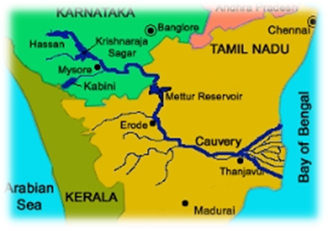Why Are Deltas Formed on the East Coast of India?
Understanding deltas:
A delta forms where a river meets still water and slows enough to drop its sediment load. It has a characteristic fan/triangle shape, building new land outward into the sea

Geographical Reasons for the formation of deltas on East coast
1. Gentle Slope
Rivers like the Ganga, Godavari, and Krishna flow through gently sloping plains, reducing their velocity and allowing sediment to settle near the coast.
2. Broad Continental Shelf
The east coast has a shallow and wide shelf, allowing sediments to spread laterally and accumulate over time.
3. Low Wave and Tidal Energy
The Bay of Bengal is relatively calm compared to the Arabian Sea. Low wave action reduces erosion, allowing deposition to dominate.
4. Large Sediment Load
East-flowing rivers originate in the Himalayas and Peninsular regions, carrying huge quantities of alluvium that aid delta formation.
5. Long River Courses
Many rivers travel long distances before reaching the sea, increasing the opportunity for sediment deposition.
6. Favorable Conditions
These factors lead to the formation of fertile, fan-shaped deltas like:
• Ganga-Brahmaputra-Meghna Delta

• Godavari Delta

• Krishna Delta

• Cauvery Delta

• Mahanadi Delta

Why Not on the West Coast?
1. Steep Continental Shelf
- The continental shelf is the submerged extension of the continent under the sea.
- On the west coast, this shelf is narrow and steep, meaning the sea bed drops off quickly.
- As a result, rivers rapidly drop their sediments into deep water, where they get scattered and do not accumulate near the mouth of the river.
- Delta formation requires shallow and wide shelves to allow sediment buildup, which is more typical of the east coast.
2. High Gradient Rivers
- Rivers on the west coast like the Narmada, Tapi, and Mandovi have shorter courses and steeper gradients.
- A steep gradient causes the river to flow swiftly, carrying sediments quickly to the sea without giving time for deposition.
- In contrast, east coast rivers like the Ganga, Godavari, and Krishna have gentle slopes, which encourage sediment deposition and delta formation.
3. Strong Tidal Currents and Erosional Forces
- The Arabian Sea experiences stronger wave action, tides, and coastal currents compared to the Bay of Bengal.
- These forces erode the coastline and wash away river sediments, making it difficult for deltas to form.
- Deltas require calmer water bodies to allow sediments to settle and accumulate, which is more prevalent on the east coast.
4. Lack of Large River Systems
- The west coast mainly has short rivers with small drainage basins and limited water and sediment flow.
- Examples include Periyar, Mandovi, Narmada, and Tapi.
- These rivers do not carry enough sediment to create large deltas.
- The east coast, by contrast, has huge river systems like the Ganga-Brahmaputra, Godavari, Krishna, and Mahanadi, which carry massive amounts of sediment and form large deltas.
5. Western Ghats Proximity to the Coast
- The Western Ghats are a mountain range that runs very close and parallel to the west coast.
- This leaves very little flat land between the mountains and the sea for rivers to meander, slow down, or deposit sediments.
- Without space to spread out, rivers cannot form distributaries, which are essential for delta formation.
- On the east coast, Eastern Ghats are more eroded and lie farther inland, giving rivers more room to spread out and form deltas.



